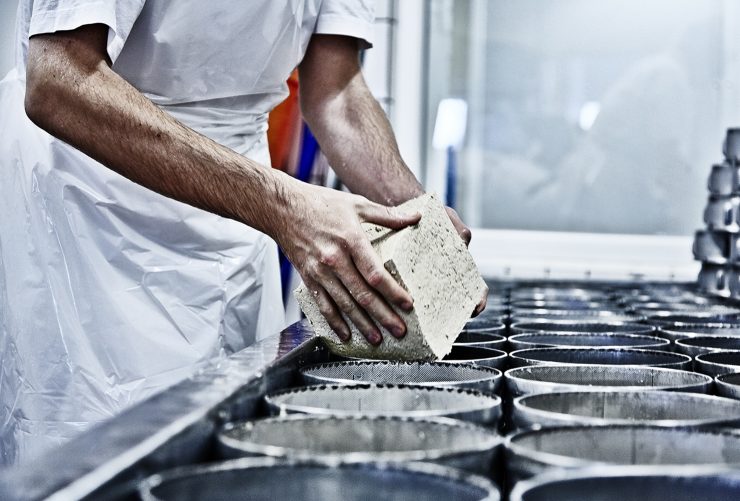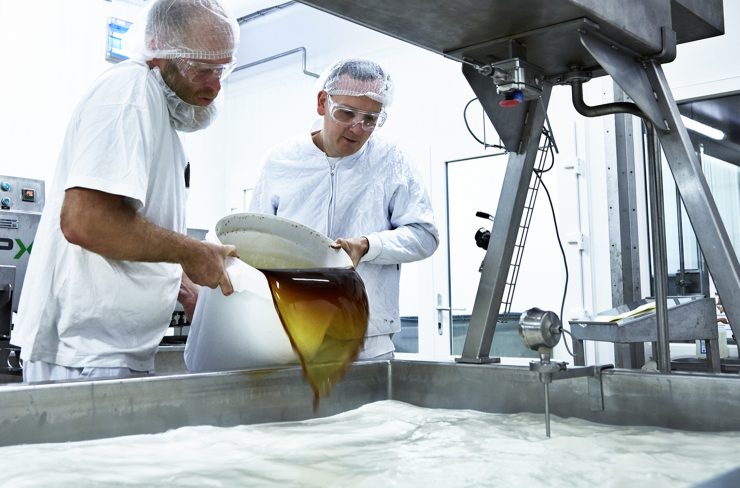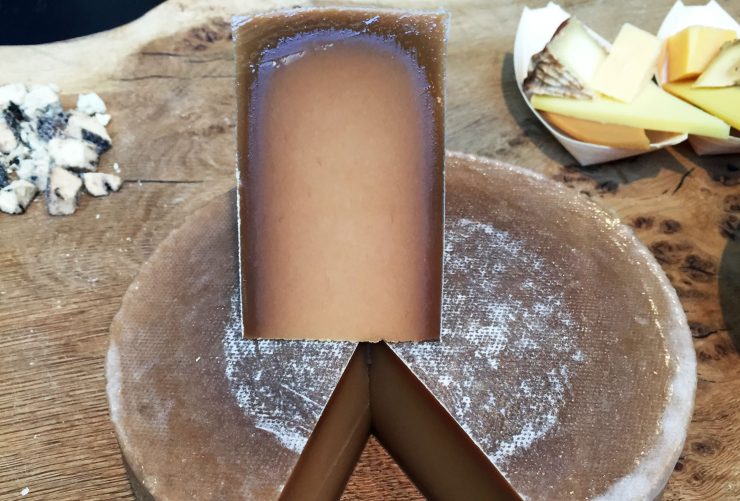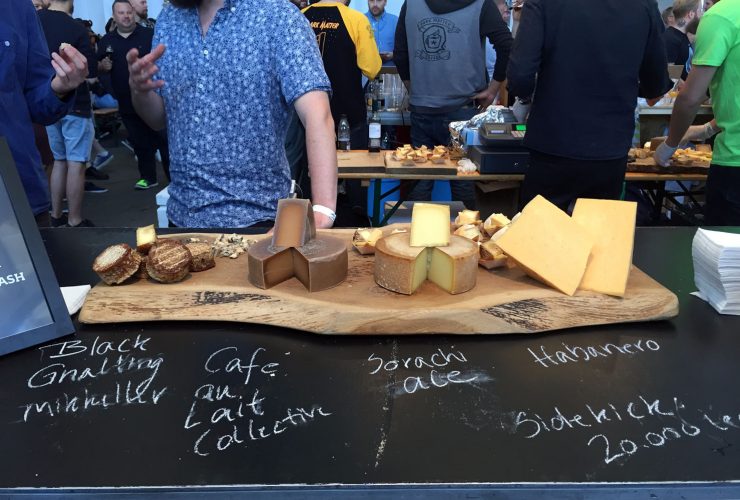
The quest for a delicious coffee cheese is soldiering on in Copenhagen, where The Coffee Collective and Arla Unika are at it again with the latest salvo in their unique snackable collaboration.
When last we spoke to The Coffee Collective’s Klaus Thomsen in 2014, the two companies had just begun to combine forces. Thomsen and Mads Østergaard-Clausen of Unika, a boutique brand of larger Danish dairy Arla, had begun work on their inaugural batch of an aged, firm, coffee-infused cheese. This May, the first production batch of the team’s coffee cheese was unveiled at the Mikkeller Copenhagen Beer Celebration to much nibbling fanfare.
Lucky Copenhagen residents will have even more to gloat about this week when The Coffee Collective and Arla Unika debut the coffee cheese to the general public with a series of coffee, cheese, and coffee-cheese tasting events in the city. To learn more, I spoke with 2006 World Barista Champion Thomsen about what he learned in his cheesemaking adventures, and about the finer pleasures of coffee cheese.

Congratulations on officially launching your coffee cheese! What’s different now than the prototypes?
Klaus Thomsen: There’s several things. There’s the coffee itself. We chose to go with [only] one of the coffees that we used in the prototypes, which is the Finca Vista Hermosa from Guatemala. And we brewed more coffee for this one, and we brewed it a lot better. We did a combination of two brew types, which was, to be honest with the coffee people, because of the logistic challenges we had of brewing 250 litres of coffee in a limited time. I brought a gallon FETCO and did batches, which was way too slow, because it needs some recovery time between each batch and so on. We did that and we brewed an extra-strong high-yield brew from the FETCO, so it came out at 20% extraction yield but at a TDS of 1.80, so we were updosing heavily but still trying to extract 20% from the updosed coffee. The 250 litres of coffee was going to be diluted into 2,500 litres of organic whole milk.
To brew 250 liters of coffee we also needed to do basically a giant cupping bowl, so we got these 6,000-watt heating elements, which were the most insane things I’ve ever seen, like, so much electricity. And we dumped them into these big 50-liter buckets of pure [reverse osmosis] water, and we raised them to 92°C and dumped in the coffee and mixed it with a big steel spoon. It was actually very hygienic because it was at a dairy farm and they’re all about the hygiene. We let it sit for four minutes, broke it, and then instead of skimming we poured the whole thing through a very fine cheesecloth nylon filter, and then we instantly cooled all the coffee in a big ice bath, and covered it with lids, and then we put it in a big fridge overnight, all the brewed coffee. The next morning we put it into the milk.

Wow. So how was this brewed “better” than the time before?
The time before we were brewing on just a regular home machine and the grinder was pretty bad. This time we had an EK43, and it actually does matter, for the quality of this I think. We TDS and Extract Mojo’d everything so we could tell how everything was brewed, and we could tell when we opened the coffee the next morning, it smelled really fresh, it didn’t smell stale, it smelled incredibly aromatic and sweet. When we put it into the milk, we could tell that we had much more coffee in the big café au lait, which is basically what we made. We could tell by the color change that this would be more coffee-ish.
Can you tell us about the dairy farm you did this at?
Tistrup Mejeri is one of the oldest dairy farms in Denmark, they have this amazing dairy or lactic culture, or starter as they call it, from 1942. It’s been alive since then, it gets a little bit of fresh milk every day. And it’s kind of crazy because when it’s been alive this long, it’s super-developed, it’s a big combination of microorganisms. They explained to me that typically when you have this kind of lactic culture, it’s kept in this sterile closet that nobody has access to because everybody is afraid it’s going to die. But this one is kept out in the open and there are two guys who take care of it in two shifts overlapping. It’s sort of like it has an immune system of its own. It makes the whole cheese more acidic and it’s more active in a lot of ways.
Also, I think the milk we used this time is better than what we used the first time around, it was completely fresh from the dairy farm, an organic milk from the west part of Denmark. Where I’m from.
How long did this batch take from start to finish?
It’s been resting since the 28th of September, so…it’s 8 months. Wow.

So what’s the cheese like?
The cheese we based it from is a Swedish Prästost, which means a priest cheese, a specific Swedish kind of cheese which usually crumbles awfully. You cut it and it falls apart. We didn’t want it to crumble like that, we wanted you to actually cut it and have it not go everywhere. But because we added so much liquid through the coffee it’s much firmer, you can cut it with a cheese plane but also with a knife if you want.
It still keeps aging from now on, if you take it home and you put it in your fridge you can dry it out more if you leave it a little open and then it will become really hard and you can cut really thin slices that are really snacky. It’s quite hard towards the edges but it’s still relatively soft in the middle. We decided to take it now because at this stage it still has some elasticity in the middle which keeps some of the acidity as well. If you dry it more, and rest it more, it becomes a little drier, but maybe you lose some of the acidity.
The funny thing with the prototype is that if we gave it to people and didn’t tell them, a lot of people guessed it had meat in it. It was really umami, and that can happen with quality cheeses. We didn’t want it to be like strong coffee everywhere, we wanted it to be relatively subtle so that it’s a cheese with some coffee flavor, not a coffee with some cheese flavor.
One of our ideas for the release of the coffee cheese is to try coffee and cheese pairings, and Unika reach a much broader, an older clientele, who might not have really caught on to Third Wave coffee and maybe don’t have one of our coffee shops near them. It’s really interesting to see that they react really positively to this combination and these thoughts about it.

Where can people try it?
The cheese will be available in chunks to buy at Unika shops in Copenhagen and Aarhus, and we will have some at the Godthåbsvej Coffee Collective roastery site. And we’ll have it on the menu, somehow.
In what ways might you offer it on your food menu at Godthåbsvej?
We have no idea. It’s a completely new thing! When we started doing the cheese from the prototype, we agreed that it’s a really great snack cheese, one that you want to eat just a little bit of, maybe with a coffee but not even that. A lot of the really fun cheeses they do are meant to just be eaten on their own. And we think it tastes really great in really thin slices on rye bread, the Danish rugbrød, but also Swedish knäckebröd, the crispy thin bread, I think it’s really good on that in really thin slices.
And from there we need to give it to someone, some chefs who are really creative, to try it out. I picture it grated like a Comte and releasing new flavors, and it’ll be different to see how it melts in different applications.
We had it last year but just served as slices with some marmalade that was paired with a coffee, and it was really good. But I think that we can be more creative than that hopefully.

How much did you make, and what will it cost?
We made 120 cheeses of 2 kilos. Up to 10% of that weight is lost during the aging which in fancy cheese terms is called affinage. The price will be DKK 300/kg in stores.
The cheese is something we think we will continue to produce, but we see it as a work in progress. The next cheese we’ll need to produce quite soon, because it needs resting time, and we really want to develop it more—it’s not like we think it’s something we got completely right the first time, it’s a completely new product category that we need to develop.
The Arla Unika/Coffee Collective cheese collaboration will launch Friday, May 27 at the Arla Unika Shop in Torvehallerne Market with a coffee brewing and cheese tasting from 10-1 hosted by Østergaard-Clausen and Thomsen. From 2pm, a coffee and cheese pairing will take place at The Coffee Collective Godthåbsvej location.
Liz Clayton is the associate editor at Sprudge.com. Read more Liz Clayton on Sprudge.
Photographs courtesy of The Coffee Collective and Arla Unika.
The post Coffee Cheese! In Copenhagen With Coffee Collective’s Klaus Thomsen appeared first on Sprudge.

